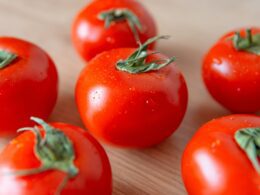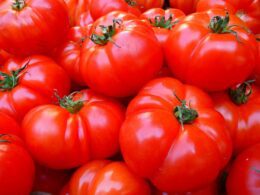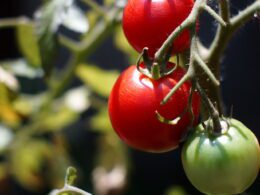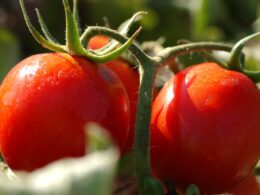You’ve lovingly planted your tomato garden, hoping for a bountiful harvest of plump, juicy tomatoes. But as the days go by, you start noticing that your plants aren’t quite thriving as they should be. Could it be that they need a little extra nourishment?
Knowing when and how to fertilize your tomatoes is crucial to their overall health and productivity. In this article, we’ll help you identify the signs of nutrient deficiency in your tomato plants and understand their specific nutrient requirements. We’ll also guide you in choosing the right fertilizer and teach you proper fertilizing techniques to ensure the safety and wellbeing of your precious tomato garden.
With these tips in hand, you’ll be well on your way to growing strong, healthy tomatoes that are sure to make your taste buds sing!
Identifying Signs of Nutrient Deficiency
Wondering if your tomato plants lack essential nutrients? Keep an eye out for signs of nutrient deficiencies. By spotting issues early, you can ensure a healthy harvest.
Yellowing leaves, especially on the lower part of the plant, may signify nitrogen or magnesium deficiency. Stunted growth and small leaves could also indicate insufficient nitrogen intake. Purple or brown spots on foliage might point to potassium deficiency. Curling or twisting leaves with yellow veins may mean a lack of iron or manganese.
To help your tomato plants thrive and protect them from harm, quickly address any issues as soon as you spot them. Apply appropriate fertilizers based on your plants’ specific needs. For yellow leaves, use nitrogen-rich fertilizer. For brown spots, use potassium-heavy fertilizer. Regularly monitor your plants’ health and provide timely interventions for an abundant harvest full of essential nutrients.
Understanding Tomato Plant Nutrient Requirements
To grasp your tomato plant’s nutrient requirements, you’ve got to pay attention to their growth and appearance. Like any other living organism, tomato plants need a balanced diet of essential nutrients in order to thrive.
These key nutrients include nitrogen (N), phosphorus (P), and potassium (K), also known as the primary macronutrients. Additionally, your tomatoes will require secondary macronutrients like calcium (Ca), magnesium (Mg), and sulfur (S) along with some micronutrients such as iron, manganese, zinc, copper, boron, and molybdenum.
Feeding your tomatoes with the right amount of nutrients ensures that they grow strong stems, healthy foliage for effective photosynthesis, an abundant root system for water absorption and the production of tasty fruits.
A general rule is to start by providing a balanced fertilizer during planting and then switch to a low-nitrogen formula when fruit sets in. You can use either organic or synthetic fertilizers depending on your preference; just make sure you follow the manufacturer’s guidelines for application rates.
Pay close attention to your tomato plants throughout their growth stages; this way you’ll be able to spot any signs of nutrient deficiencies early on before it becomes detrimental to their health. If you notice symptoms like yellowing leaves or stunted growth despite proper watering practices, it could indicate that additional fertilization is needed.
Adjusting your feeding schedule accordingly can help ensure that your tomato plants develop into strong producers with mouthwatering fruits for you and your family to enjoy all season long!
Choosing the Right Fertilizer for Your Tomatoes
When choosing the right fertilizer for your tomatoes, it’s essential to consider whether you want organic or synthetic options, and if you need a balanced or specialty formula.
Organic fertilizers provide nutrients more slowly but are environmentally friendly, while synthetic ones offer quicker results, but may harm beneficial soil life.
Balanced fertilizers contain equal amounts of nitrogen, phosphorus, and potassium, whereas specialty fertilizers target specific nutrient needs according to your tomato plants’ requirements.
Organic vs. Synthetic Fertilizers
Deciding between organic and synthetic fertilizers can greatly impact the health of your tomato plants and their nutrient needs. Organic fertilizers, such as compost, manure, or bone meal, release nutrients slowly over time as they break down in the soil. This provides a steady supply of nutrients to your plants while also improving soil structure and promoting beneficial microbial activity.
Synthetic fertilizers, on the other hand, are chemically produced and provide a quick-release of nutrients directly to your plants. While this may seem like an advantage, it can sometimes lead to over-fertilization which may harm your plants or even leach into nearby water sources.
When considering safety for you and the environment, organic fertilizers are generally considered safer than synthetic options. As mentioned earlier, they help improve soil quality by encouraging beneficial organisms that contribute to overall plant health. Additionally, because organic materials release nutrients more slowly than synthetic alternatives, there is less risk of over-fertilization and potential damage to nearby ecosystems from nutrient runoff.
On the flip side, some synthetic fertilizers contain added chemicals that may be harmful if ingested or exposed to skin; however, following proper application guidelines should minimize these risks.
Ultimately it’s up to you whether you prefer using natural methods or quicker-acting synthetics – just remember that understanding your plant’s needs will ensure their safe growth and bountiful harvest!
Balanced vs. Specialty Fertilizers
So, let’s dive into the world of balanced and specialty fertilizers and figure out which one’s best suited for your tomato plants!
Balanced fertilizers contain equal amounts of nitrogen (N), phosphorus (P), and potassium (K) in their formulations. These are essential nutrients that promote overall plant health and growth. On the other hand, specialty fertilizers have different ratios of N-P-K to address specific nutrient deficiencies or cater to certain plant types.
If your tomato plants are growing in well-maintained soil with no evident signs of nutrient deficiency, a balanced fertilizer is a safe choice. It provides equal parts of all three primary nutrients, ensuring your plants get everything they need for healthy growth.
For tomatoes specifically, you may consider using a specialty fertilizer with higher phosphorus and potassium content to support fruit development and quality. This type of fertilizer can help if you notice slow fruiting or poor-quality tomatoes.
To make an informed decision between balanced or specialty fertilizers, it’s best to conduct a soil test first. This will reveal any nutrient deficiencies in your garden so you can choose the right fertilizer accordingly.
Regardless of which fertilizer type you choose, always follow package instructions for application rates and frequency – this ensures safety for both your tomato plants and yourself.
In conclusion, selecting the right fertilizer depends on factors like existing soil conditions and specific needs of your tomato plants. By understanding these factors and choosing between balanced or specialty fertilizers accordingly, you’ll be able to provide a safe environment where your tomatoes can thrive!
Proper Fertilizing Techniques and Timing
To ensure your tomatoes get the proper nutrients they need, it’s crucial to master proper fertilizing techniques and timing.
Start by conducting a soil test to determine nutrient levels. Then, apply the right fertilizer using appropriate application methods. Finally, establish a suitable fertilizing frequency for the best results in tomato growth and production.
Don’t forget to use contractions!
Soil Testing
Curious about your tomato plants’ nutritional needs? Soil testing is a fantastic starting point! By conducting a soil test, you can determine the levels of essential nutrients in your garden’s soil, allowing you to provide the right fertilizer for your tomatoes.
This valuable information will help ensure that your plants thrive and produce delicious fruits, while also preventing potential problems related to over-fertilization or nutrient deficiencies.
A proper soil test can provide insights into several crucial factors:
- The pH level of your soil: This affects nutrient availability and overall plant health.
- Nutrient content: Nitrogen (N), phosphorus (P), and potassium (K) are particularly important for tomato growth.
- Organic matter content: Healthy organic matter promotes strong root systems and boosts nutrient retention.
- Presence of micronutrients: Elements such as calcium, magnesium, and iron play vital roles in plant development.
- Potential contaminants: Heavy metals or other unwanted substances can negatively impact plant growth and safety.
With this wealth of information at your fingertips, you’ll be able to make informed decisions about fertilizing your tomatoes, ensuring their health and productivity while also safeguarding them from potential hazards.
Application Methods
Wondering how to apply fertilizer for those juicy tomatoes? Let’s dive into some effective application methods! Applying fertilizer correctly not only ensures the safety and health of your tomato plants, but also maximizes their growth potential. Knowing when and how to fertilize your tomatoes is essential in providing them with the right amount of nutrients they need.
There are two main ways to apply fertilizer: top-dressing and side-dressing. Top-dressing involves sprinkling the granular fertilizer evenly over the soil surface, while side-dressing requires you to dig a shallow trench near the plant’s base and place the fertilizer inside. To help you decide which method is best for you, here’s a quick comparison table:
| Method | Pros | Cons |
|---|---|---|
| Top-Dressing | Easy to apply; Requires less digging | May require more frequent applications |
| Side-Dressing | Targets root zone; Nutrients release gradually | Requires digging; Slightly more time-consuming |
Whichever method you choose, always remember that safety comes first. Properly applying fertilizer not only improves your tomato harvest but also contributes to maintaining a healthy garden environment. Happy growing!
Fertilizing Frequency
It’s crucial to find the perfect balance when it comes to fertilizing frequency, as over or under-fertilizing can impact your tomatoes’ growth and overall garden health.
Generally, you should fertilize your tomato plants every 4-6 weeks during the growing season, starting when you first transplant them into the garden. However, this may vary depending on factors such as soil type, weather conditions, and the specific needs of your tomato variety.
To ensure that you’re providing a safe environment for your tomatoes and not overdoing it with fertilizer, always monitor their growth and appearance. Watch out for signs of nutrient deficiency like yellowing leaves or stunted growth.
If these symptoms persist even after applying fertilizer at recommended intervals, consider getting a soil test done to determine if any adjustments need to be made in your fertilizing routine.
By paying close attention to your plants’ needs and adjusting as necessary, you can maintain a healthy garden while keeping safety top of mind.
Additional Tips for a Healthy Tomato Garden
To maintain a thriving tomato garden, consider these extra tips for optimal plant health and growth. Besides providing your tomatoes with the right amount of fertilizer, there are other factors to keep in mind to ensure their well-being and productivity. By paying attention to these details, you’ll be able to grow a bountiful harvest that brings joy and satisfaction.
-
Choose the right tomato variety: Selecting a suitable variety for your specific climate and space is crucial. Some tomato plants thrive in warmer temperatures while others prefer cooler climates. Make sure you’re growing the right type so they can flourish.
-
Proper watering techniques: Tomatoes need consistent moisture levels without over-watering or under-watering them. This balance helps prevent diseases like blossom end rot and fosters healthy fruit development.
-
Regular pruning: Regularly trimming your tomato plants not only encourages better air circulation but also helps direct energy towards fruit production rather than excessive foliage growth.
By incorporating these additional care practices into your gardening routine, you’ll create an environment where your tomatoes can prosper. As a result, you’ll enjoy the rewards of fresh, home-grown produce that offers both safety from pesticides typically found in store-bought options and satisfaction from nurturing something with your own hands. Keep in mind that it’s all about finding what works best for you and your garden – with patience and persistence, you’ll soon have a flourishing tomato haven that provides delicious fruits for seasons to come.
Conclusion
In conclusion, it’s essential to keep an eye on your tomato plants for signs of nutrient deficiency and understand their specific needs. By choosing the right fertilizer and applying it correctly, you’ll ensure a bountiful harvest.
Remember, maintaining a healthy tomato garden is an ongoing process. Keep these tips in mind as you grow your tomatoes, and enjoy the fruits of your labor!









